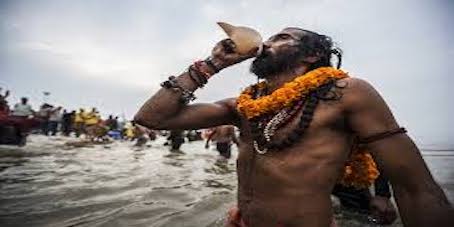Amidst the risk of covid infection, shrugging off the fears, India holds the most auspicious event in the Hindus calendar: Mahakumbh Mela.
This year the festival officially began on January 14 with Haridwar as its host, and several million are expected to throng the city over the coming seven weeks.
When Kumbh (a pitcher) of Amrit produced from ‘Sagar-Manthan’, it was Lord Vishnu who then disguised himself as Mohini and took it away from the demons who claimed it It is believed as when he was taking the ‘Amrit’ to heaven, few drops from Kumbh fell on four sacred places which become Haridwar, Ujjain, Nasik, and Prayag, making them auspicious and pure. The flight lasted 12 divine days, which is equivalent to twelve human years, and therefore, the mela is celebrated every 12 years, staggered at each of the four sacred sites in this cycle.
This marked the beginning of Kumbh Mela and the rivers at these four sacred places are considered holy for people consider that taking bath in them will give them purity. Considered as one of the biggest religious gatherings in the world, Kumbh Mela holds an important and sacred place among Hindus.
The pandemic has already disrupted religious tourism which is indeed the backbone of Uttarakhand’s economy. The Char-Dham yatra, which accounts for the majority of revenue for state government resumed late with restriction and even the annual Kanwar yatra couldn’t take place due to coronavirus. In these challenging times, Kumbh Mela becomes even more significant.
While the Haridwar District Tourism is looking it at as the opportunity to revive the tourism of the state, the state government is also leaving no chance to make it safe for people.
The mela, that witness gathering of millions, is distinctive in itself.
First, the schedule of Kumbh has changed. The previous Kumbh was celebrated in 2010. The next one was to be held in 2022 but is happening a year earlier. Mahant Narendra Giri, head of Akhil Bharatiya Akhara Parishad said that it is due to auspicious dates,
Not only this but this time Mahakumbh is also of a shorter format. The state government announced that the period of celebration at this year’s Kumbh Mela would be reduced from three and half months to 48 days. For the past several centuries no Mahakumbh in Haridwar got abridged whether due to war, natural disaster, or pandemic. 2021 Mahakumbh will be the first abridged one.
The second—crowd management. The mela, which witnessed a staggering seven million devotees last time, will operate differently due to the covid restrictions.
The government has opted for different ways to manage the crowd.
Employing technology, the government has decided to provide e-pass to people to visit the Mahakumbh. For taking part in shahi snans (March 11, April 12, April 14, and April 27), pilgrims have to get themselves registered on a website and choose a specific ghat for them to bathe. Each pilgrim will then be allotted a specific time and will get only 15 minutes.
The entire area is marked with GIS mapping, for any area cross the permissible limit of the crowd at any point in time, the control room will be alerted for the same. Further, the entire mela area along with all 107 ghats too have been divided into red, yellow, and green zones, according to their vulnerability.
The administration has also planned to increase the time during rush hours to reduce the crowd density.
Adding to that, IG Sanjay Gujral clarified that pilgrims have to produce a pass at the border itself during shahi snans.
“The pandemic is a bit of a worry, but we are taking all precautions,” said organizer Siddharth Chakrapani, The government has already made covid test necessary for everyone visiting the mela.
The festival, recognized as an element of Indian cultural heritage by UNESCO, welcomed a staggering 55 million people in 48 days during the last edition in Prayagraj in 2019.
Not only Uttrakhand’s government, but Uttar Pradesh’s government is also playing on its toes as devotees gathered in Prayagraj for Magh mela. The mela marks the Makar Sankranti celebrations and is held on the sands of Prayagraj where the Saraswati, Ganga, and the Yamuna meet. The Yogi Adityanath government seems alert on the Covid-19 front. It has said the “kalpwasis” visiting Magh Mela this year in Prayagraj will have to undergo a Covid-19 test. State Chief Secretary R K Tiwari is reported to have said that all “kalpwasis” coming to the mela will have to mandatorily undergo the RT-PCR test.
The Kumbh is a representative of the deep-rooted values and ethos of Bharat – the sacredness of nature, the spirit of sewa, and equality by bringing millions of individuals together, irrespective of their sociocultural or economic backgrounds. This forty-eight-day spectacle will remind the world of timelessness of Bharat’s civilization .


